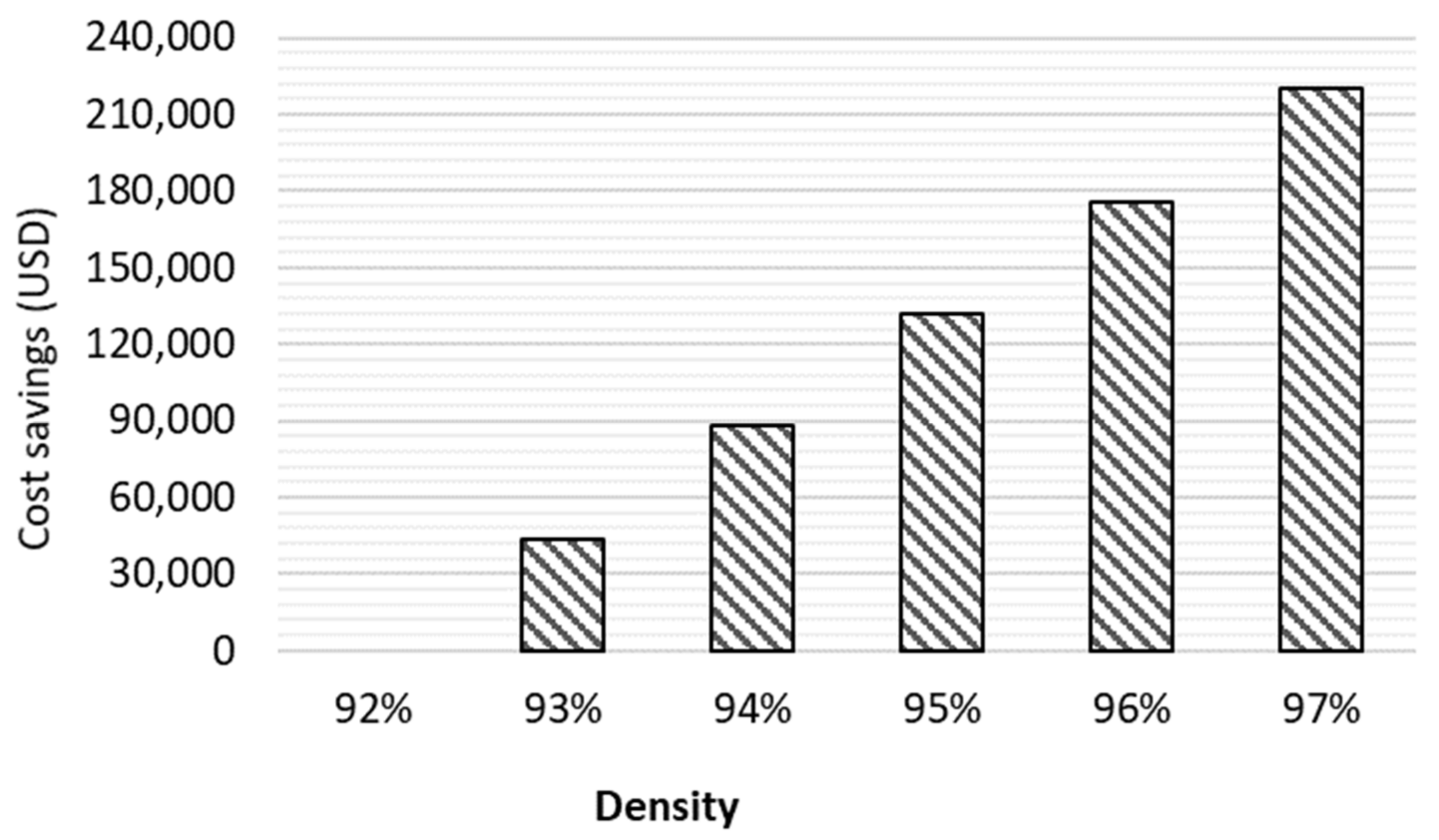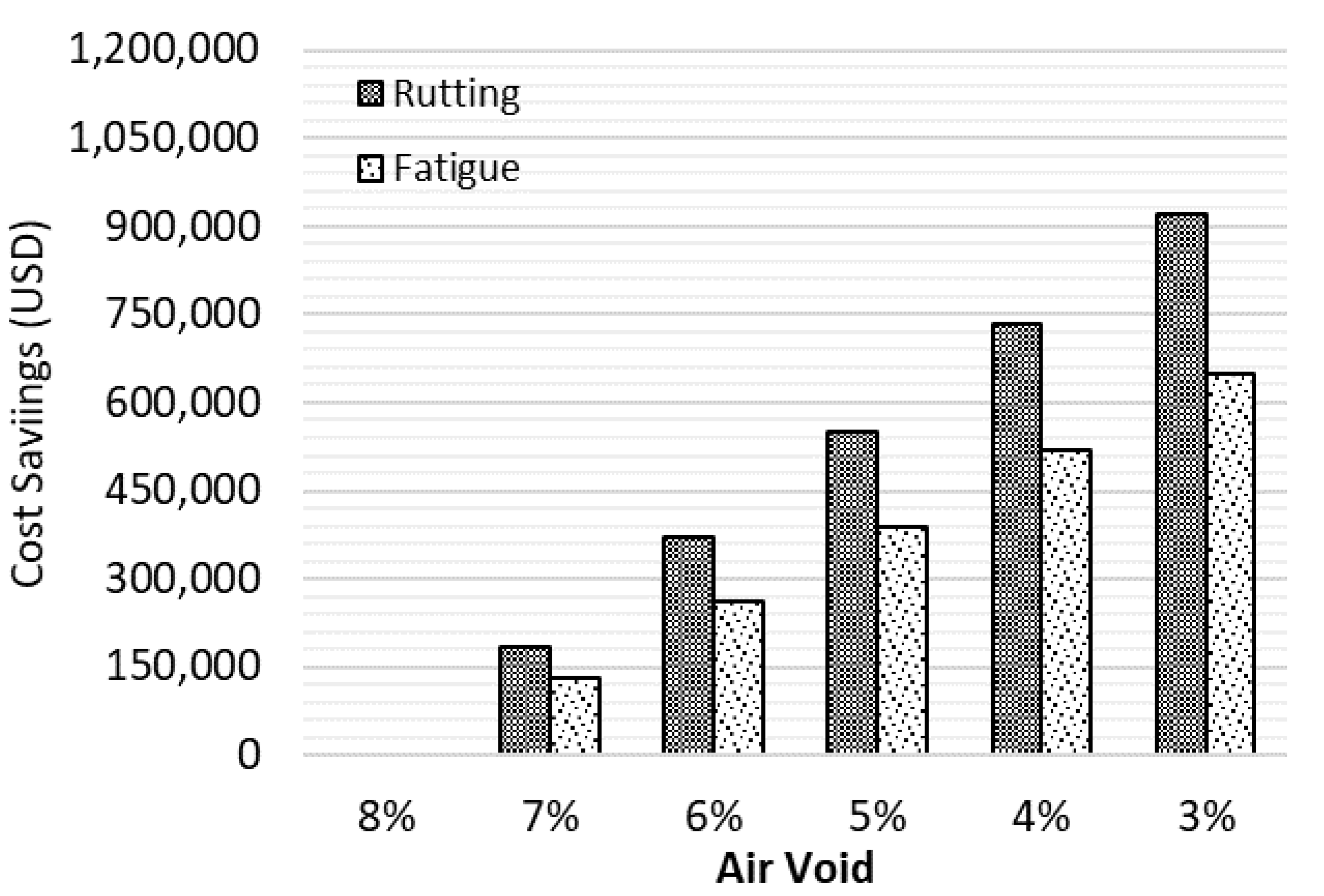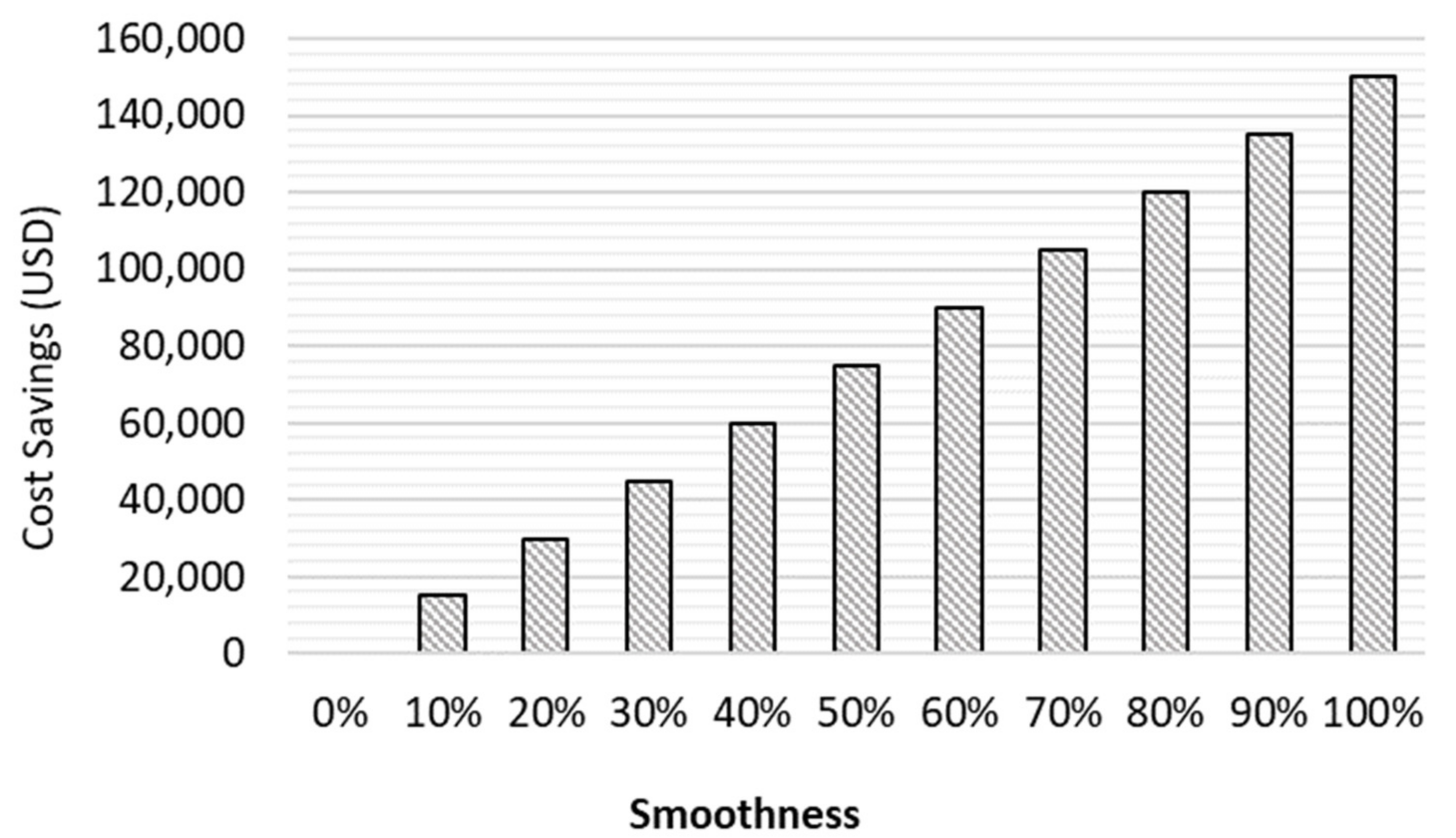Cost-Effectiveness of Conventional Compaction (CC) and Intelligent Compaction (IC) Methods of Asphalt Pavement Overlay
Abstract
:1. Introduction
2. Methodology
2.1. Initial Construction Cost
Operator Cost per Hour)] + [(QC/QA Cost per Area) × (Area)]
Cost per Hour) + (GPS Cost per Hour)] + [(QC/QA Cost per Area) × (Area)]
2.2. Roadway Lifecycle Cost
3. Results
3.1. Initial Construction Cost
3.1.1. Conventional Compaction (CC)
3.1.2. Intelligent Compaction (IC)
3.2. Roadway Lifecycle Cost
3.2.1. Case 1 (Fatigue Life Consideration)
3.2.2. Case 2 (Air Void Content Considering Unit Savings)
- (i)
- The pavement compacted with conventional compaction has a density of 92%.
- (ii)
- The traditional service life of asphalt pavement overlay compacted with conventional compaction is 20 years.
- (iii)
- The cost for asphalt overlay for both compactions at the end at 92% air void are considered the same, at USD 500,000.
- (iv)
- To understand the cost savings due to in-place density with IC the study considered five density scenarios: 93%, 94%, 95%, 96%, and 97% based on the previously mentioned reasoning, as air void should not drop below 3%.
3.2.3. Case 3 (Air Void Content Considering Rutting and Fatigue Performance)
- (i)
- The pavement compacted with conventional compaction has a minimum air void content of 8%.
- (ii)
- The traditional service life of asphalt pavement overlay compacted with conventional compaction is 20 years.
- (iii)
- The cost for asphalt overlay for both compactions at the end at 8% air void content is considered the same, at USD 500,000, so the annual cost for compaction is USD 25,000.
- (iv)
- To understand the cost savings due to rutting and fatigue improvement with IC compared to conventional compaction the study conducted a simple calculation and varied the air void content from 8% to 3%.
3.2.4. Case 4 (Smoothness Consideration)
- (i)
- NCHRP estimated that a 15% increase in pavement life can be assured by having a 50% increase in smoothness. As a result, it can be deduced that for every 10% increase in smoothness, the pavement life can be increased by 3%.
- (ii)
- The traditional service life of asphalt pavement overlay compacted with conventional compaction is 20 years.
- (iii)
- The cost for asphalt overlay for both compactions at the end at 0% smoothness is considered the same, at USD 500,000, so the annual cost for compaction is USD 25,000.
- (iv)
- To understand the cost savings due to smoothness with IC compared to conventional compaction the study conducted a simple calculation and varied the smoothness achievement of IC ranging from 0% to 100% with an interval of 10%.
4. Conclusions
- (1)
- According to the published literature review and industry professionals the overall study on the cost-effectiveness between conventional and intelligent compaction methods is limited.
- (2)
- The initial construction cost of conventional compaction is higher compared to intelligent compaction. Based on the results of the cost input, conventional compaction is approximately 4.1% higher than the intelligent compaction.
- (3)
- With conventional compaction the cost factor that increases the initial construction cost is the QC/QA of the asphalt pavement overlay, whereas intelligent compaction has the lowest cost on QC/QA due to its initial calibration done on the test section.
- (4)
- With IC compaction the cost of the intelligent roller plays a vital role on the initial construction cost, as the cost of the intelligent roller is higher than the conventional roller.
- (5)
- Roadway lifecycle cost is measured based on the consideration of fatigue life and air void content. In both cases, it was found that IC can significantly reduce the agency cost compared to conventional compaction.
- (6)
- Based on the 25-year analysis period, the agency cost can be reduced by approximately 62% per lane-mile compared to conventional compaction due to the increase of fatigue life with IC method.
- (7)
- Based on the 20-year analysis period, significant cost saving for the agency was found on both cases considering the pavement life extension due to an increase in density and smoothness. Asphalt pavement overlay constructed at 97% field density (or at 3% air void content) using IC construction can help the agency to reduce the cost by approximately 44% compared to conventional compaction.
Author Contributions
Funding
Institutional Review Board Statement
Informed Consent Statement
Data Availability Statement
Acknowledgments
Conflicts of Interest
References
- Hu, W. Evaluation of Intelligent Compaction Technology in Asphalt Pavement Construction and Laboratory Compaction. Ph.D. Dissertation, University of Tennessee, Knoxville, TN, USA, 2018. [Google Scholar]
- Mooney, M.A.; Rinehart, R.V.; Facas, N.W.; Musimbi, O.M.; White, D.J.; Vennapusa, P.K.R. Intelligent Soil Compaction Systems. National Cooperative Highway Research Program, Report 676; Transportation Research Board: Washington, DC, USA, 2010. [Google Scholar]
- Chang, G.K.; Xu, Q.; Rutledge, J.L.; Garber, S.I. A Study on Intelligent Compacting and In-Place Asphalt Density; (No. FHWA-HIF-14-017); Federal Highway Administration, Office of Pavement Technology: Washington, DC, USA, 2014. [Google Scholar]
- Chang, G.; Xu, Q.; Rutledge, J.; Horan, B.; Michael, L.; White, D.; Vennapusa, P. Accelerated Implementation of Intelligent Compaction Technology for Embankment Subgrade Soils, Aggregate Base, and Asphalt Pavement Materials; Federal Highway Administration: Washington, DC, USA, 2011.
- Furuya, H.; Tsukimoto, Y.; Koseki, H.; Mansell, T.; Gallivan, V.; Uchiyama, K. Innovative QC/QA compaction method for HMA pavement using intelligent compaction (IC) technology. In Proceedings of the 11th international conference on asphalt pavements, Nagoya, Japan, 1–6 August 2010. [Google Scholar]
- FHWA (Federal Highway Administration). Intelligent Compaction Measurement Values (ICMV) A Road Map; FHWA-HIF-17-046; Federal Highway Administration, 2017. Available online: https://www.fhwa.dot.gov/construction/ictssc/pubs/hif17046.pdf (accessed on 23 September 2021).
- Yoon, S.; Hastak, M.; Lee, J. Suitability of intelligent compaction for asphalt pavement quality control and quality assurance. J. Constr. Eng. Manag. 2018, 144, 04018006. [Google Scholar] [CrossRef]
- Savan, C. Intelligent Compaction for Roadway Soils and Pavement. Master’s Thesis, University of Wyoming, Laramie, WY, USA, 2014. [Google Scholar]
- Savan, C.M.; Ng, K.W.; Ksaibati, K. Implementation of Intelligent Compaction Technologies for Road Constructions in Wyoming; No. MPC 15-281; North Dakota State University-Upper Great Plains Transportation Institute, Mountain-Plains Consortium: Fargo, ND, USA, 2015. [Google Scholar]
- Savan, C.M.; Ng, K.W.; Ksaibati, K. Benefit-cost analysis and application of intelligent compaction for transportation. Transp. Geotech. 2016, 9, 57–68. [Google Scholar] [CrossRef]
- The Transtec Group, Inc. Intelligent Compaction, Projects, IC Specifications; The Transtec Group, Inc., 2014. Available online: https://www.thetranstecgroup.com/fhwa-transtec-release-intelligent-compaction-guideline-documents/ (accessed on 23 September 2021).
- Xu, Q.; Chang, G.K.; Gallivan, V.L.; Horan, R.D. Influences of intelligent compaction uniformity on pavement performances of hot mix asphalt. Constr. Build. Mater. 2012, 30, 746–752. [Google Scholar] [CrossRef]
- Wyoming Department of Transportation. State Transportation Improvement Plan (STIP); Wyoming Department of Transportation, 2011; Available online: https://www.dot.state.wy.us/STIP (accessed on 23 September 2021).
- Linden, R.N.; Mahoney, J.P.; Jackson, N.C. The Effect of Compaction on Asphalt Concrete Performance. In Proceedings of the 1989 Annual Meeting of the Transportation Research Board, Washington, DC, USA, 31 March 1990. [Google Scholar]
- Aschenbrener, T.; Leiva, F.; Tran, N.H.; Hand, A.J. FHWA Demonstration Project for Enhanced Durability of Asphalt Pavements through Increased In-Place Pavement Density, Phase 2; US Department of Transportation, 2020. Available online: https://www.fhwa.dot.gov/pavement/asphalt/pubs/hif19052.pdf (accessed on 23 September 2021).
- Asphalt Institute. The Asphalt Handbook, Manual Series No. 4 (MS-4), 7th ed.; Asphalt Institute: Lexington, KY, USA, 2007. [Google Scholar]
- Tran, N.; Turner, P.; Shambley, J. Enhanced Compaction to Improve Durability and Extend Pavement Service Life: A Literature Review; NCAT, 2016. Available online: https://eng.auburn.edu/research/centers/ncat/files/reports/2016/rep16-02.pdf (accessed on 23 September 2021).
- Roberts, F.L.; Kandhal, P.S.; Brown, E.R.; Lee, D.Y.; Kennedy, T.W. Hot Mix Asphalt Materials, Mixture Design, and Construction; National Asphalt Paving Association Education Foundation: Lanham, MD, USA, 1996. [Google Scholar]
- Smith, K.; Smith, K.D.; Evans, L.D.; Hoerner, T.E.; Darter, M.I. Smoothness Specifications for Pavements; Final Report NCHRP 1-31; Transportation Research Board, 1997; Available online: https://trid.trb.org/view/576824 (accessed on 23 September 2021).




| Air Void Rate/Density | Conventional Compaction | Intelligent Compaction | Cost Savings |
|---|---|---|---|
| 92% | USD 500,000 | USD 500,000 | USD 0 |
| 93% | USD 500,000 | USD 456,000 | USD 44,000 |
| 94% | USD 500,000 | USD 412,000 | USD 88,000 |
| 95% | USD 500,000 | USD 368,000 | USD 132,000 |
| 96% | USD 500,000 | USD 324,000 | USD 176,000 |
| 97% | USD 500,000 | USD 280,000 | USD 220,000 |
| Air Void | Pavement Life Extension (by Percentage) | Conventional Compaction (Constant Pavement Life) | Intelligent Compaction (Savings of Pavement Life) | Conventional Compaction Cost (Annually) | IC Cost Saving Due to Rutting |
|---|---|---|---|---|---|
| 8% | 0% | 20 years | 0 years | USD 25,000 | USD 0 |
| 7% | 37% | 20 years | 7.4 years | USD 25,000 | USD 185,000 |
| 6% | 74% | 20 years | 14.8 years | USD 25,000 | USD 370,000 |
| 5% | 110% | 20 years | 22 years | USD 25,000 | USD 550,000 |
| 4% | 147% | 20 years | 29.4 years | USD 25,000 | USD 735,000 |
| 3% | 184% | 20 years | 36.8 years | USD 25,000 | USD 920,000 |
| Air Void | Pavement Life Extension (by Percentage) | Conventional Compaction (Constant Pavement Life) | Intelligent Compaction (Savings of Pavement Life) | Conventional Compaction Cost (Annually) | IC Cost Saving Due to Fatigue Cracking |
|---|---|---|---|---|---|
| 8% | 0% | 20 years | 0 years | USD 25,000 | USD 0 |
| 7% | 26% | 20 years | 5.2 years | USD 25,000 | USD 130,000 |
| 6% | 52% | 20 years | 10.4 years | USD 25,000 | USD 260,000 |
| 5% | 78% | 20 years | 15.6 years | USD 25,000 | USD 390,000 |
| 4% | 104% | 20 years | 20.8 years | USD 25,000 | USD 520,000 |
| 3% | 130% | 20 years | 26 years | USD 25,000 | USD 650,000 |
| Smoothness Increase | Pavement Iife Extension (by Percentage) | Conventional Compaction (Constant Pavement Life) | Intelligent Compaction (Savings of Pavement Life) | Conventional Compaction Cost (Annually) | IC Cost Saving Due to Smoother Pavement |
|---|---|---|---|---|---|
| 0% | 0% | 20 years | 0 years | USD 25,000 | USD 0 |
| 10% | 3% | 20 years | 0.6 years | USD 25,000 | USD 15,000 |
| 20% | 6% | 20 years | 1.2 years | USD 25,000 | USD 30,000 |
| 30% | 9% | 20 years | 1.8 years | USD 25,000 | USD 45,000 |
| 40% | 12% | 20 years | 2.4 years | USD 25,000 | USD 60,000 |
| 50% | 15% | 20 years | 3 years | USD 25,000 | USD 75,000 |
| 60% | 18% | 20 years | 3.6 years | USD 25,000 | USD 90,000 |
| 70% | 21% | 20 years | 4.2 years | USD 25,000 | USD 105,000 |
| 80% | 24% | 20 years | 4.8 years | USD 25,000 | USD 120,000 |
| 90% | 27% | 20 years | 5.4 years | USD 25,000 | USD 135,000 |
| 100% | 30% | 20 years | 6 years | USD 25,000 | USD 150,000 |
Publisher’s Note: MDPI stays neutral with regard to jurisdictional claims in published maps and institutional affiliations. |
© 2021 by the authors. Licensee MDPI, Basel, Switzerland. This article is an open access article distributed under the terms and conditions of the Creative Commons Attribution (CC BY) license (https://creativecommons.org/licenses/by/4.0/).
Share and Cite
Mazumder, M.; Yun, J.; Lee, S.-J.; Jeong, K.-D. Cost-Effectiveness of Conventional Compaction (CC) and Intelligent Compaction (IC) Methods of Asphalt Pavement Overlay. Sustainability 2021, 13, 11830. https://doi.org/10.3390/su132111830
Mazumder M, Yun J, Lee S-J, Jeong K-D. Cost-Effectiveness of Conventional Compaction (CC) and Intelligent Compaction (IC) Methods of Asphalt Pavement Overlay. Sustainability. 2021; 13(21):11830. https://doi.org/10.3390/su132111830
Chicago/Turabian StyleMazumder, Mithil, Jihyeon Yun, Soon-Jae Lee, and Kyu-Dong Jeong. 2021. "Cost-Effectiveness of Conventional Compaction (CC) and Intelligent Compaction (IC) Methods of Asphalt Pavement Overlay" Sustainability 13, no. 21: 11830. https://doi.org/10.3390/su132111830
APA StyleMazumder, M., Yun, J., Lee, S.-J., & Jeong, K.-D. (2021). Cost-Effectiveness of Conventional Compaction (CC) and Intelligent Compaction (IC) Methods of Asphalt Pavement Overlay. Sustainability, 13(21), 11830. https://doi.org/10.3390/su132111830






